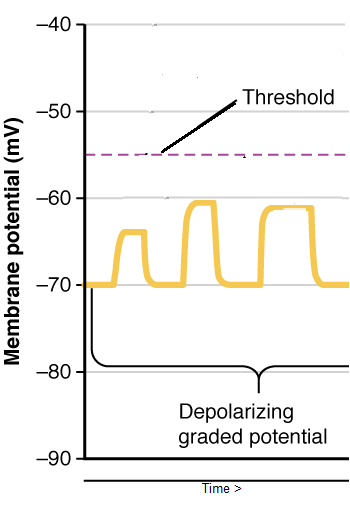The Graded Potential
Graded potentials are very different from action potentials. The term graded gives some insight to this fact. "Graded " describes the fact that the magnitude of the change in membrane potential is directly proportional to the magnitude of the stimulus. With graded potentials, a very weak stimulus will cause a very weak change in membrane potential. A very, very weak stimulus will cause a very, very weak change in membrane potential. A very, very, very weak stimulus will cause a very, very, very weak change in membrane potential. This is illustrated in the figure below. Graded is essentially the opposite of all or none. This also means that graded potentials do not have a threshold. No matter how small the stimulus, an equally small change in membrane potential will result (only a few sodium channels are opening so a smaller amount of sodium is being allowed into the cell).

Figure 5. Graded Potential. These are small changes in the membrane potential. Notice the threshold potential is the critical level to which a membrane potential must be depolarized to initiate an action potential. If threshold is not reached, these graded, or local, portentials will decrease again, called decremental conduction.
Graded membrane potentials are also called local potentials. They are called local potentials because only a local area of the cell experiences the change in membrane potential. The entire cell is not affected by the graded potential. The change in membrane potential is strongest at the sight of stimulation. The magnitude of the change in membrane potential decreases as the distance from the sight of stimulation increases or they fizzle out. This is called decremental conduction.
Think of a stadium wave - you know when people in the baseball stadium put up their hands and then the next section does the same and it goes around the whole stadium (mostly an American phenomenon). When a section of people in the stadium want to start a wave, often the people around them are not 'open' to it and the signal, like a graded potential signal, fizzles out. If, however, enough of a the signal idea gets around (enough sodium is allowed into the neuron cell body) the neighboring people (or sodium channels in this case) are 'open' to the idea, all of the next section of the stadium will raise their hands over their heads (and lower them) and we can see a wave going all the way around the stadium - it is an all-or-none signal - as long as enough graded potentials are available and threshold is reached the action potential "wave" will go all the way down the neuron.
Graded changes in membrane potential may be in either a depolarizing or hyperpolarizing direction. An excitatory stimulus would depolarize the postsynaptic membrane, called an excitatory postsynaptic potential or EPSP. The depolarization would be the result of sodium gates opening up and sodium ions diffusing into the cell. The change is said to be excitatory because it results in the membrane potential being closer to threshold. An inhibitory stimulus would have the opposite effect. An inhibitory stimulus would hyperpolarize the postsynaptic membrane called an inhibitory postsynaptic potential or IPSP. The hyperpolarization would be the result of special (ligand-gated) potassium gates opening and potassium ions diffusing out of the cell. This is said to be inhibitory because the membrane is now farther away from threshold and is less likely to be able to fire an action potential. Graded potentials may be in either direction. These inhibitory channels could also be chloride ion (Cl-) channels, since there is more Chloride outside the cell than inside the cell. Amine neurotransmitters like glycine can open chloride channels if an inhibitory signal is needed.
Drug Interaction
Several drugs will either mimic an excitatory NT or an inhibitory NT and will contain chemicals that mimic these neurotransmitters. List NTs for Exc and Inh.
Some Neurotransmitters for chemically controlled channels and their functions:
- Acetylcholine (at "cholinergic" synapse) (EPSPs)
- Norepinephrine (noradrenalin) (at "adrenergic synapse") (EPSPs)
- Serotonin (can be either)- mood, appetite, depression
- Dopamine (can be either)- Parkinson's; personality, thoughts
- Gamma aminobutyric acid (GABA) (IPSPs)- anxiety
- Glycine (IPSPs) - inhibitory in spinal cord, brain; may help sleep quality
- Others (including NO and CO) - peptides - thirst, drinking behavior


